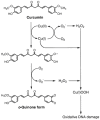Cytotoxic activity of curcumin towards CCRF-CEM leukemia cells and its effect on DNA damage
- PMID: 20032896
- PMCID: PMC6255027
- DOI: 10.3390/molecules14125328
Cytotoxic activity of curcumin towards CCRF-CEM leukemia cells and its effect on DNA damage
Abstract
The cytotoxic activity of curcumin towards CCRF-CEM human T-cell leukemia cells was measured by the MTT assay. Tumor cells were more sensitive to the cytotoxic activity of curcumin or curcumin-Cu (II)compared to normal cells, and the IC(50) of curcumin towards CCRF-CEM cells was 8.68 microM, and that of curcumin-Cu (II) was 8.14 microM. The cell cycle distribution of curcumin-treated CCRF-CEM cells was analyzed by flow cytometry. DNA damage induced by oxidants such as curcumin-Cu (II) ions is considered as one of the main causes of cell inactivation. Therefore, we analyzed the effect of curcumin on DNA damage by agarose gel electrophoresis and atomic force microscopy (AFM). Gel electrophoresis analyses showed that curcumin or Cu (II) alone failed to cause DNA damage in pBR322 plasmid DNA as compared with the normal plasmid. However, DNA plasmids were mostly damaged after treatment with curcumin of different concentrations in the presence of Cu (II). Two forms were observed by means of AFM: closed circular plasmids and linear plasmids. DNA damage induced by a combination of curcumin and Cu (II) was also found by agarose gel electrophoresis, which was applied as control method to verify the results obtained by AFM.
Figures







Similar articles
-
Cytotoxic activity of isoliquiritigenin towards CCRF-CEM leukemia cells and its effect on DNA damage.Planta Med. 2009 Aug;75(10):1134-40. doi: 10.1055/s-0029-1185479. Epub 2009 Mar 16. Planta Med. 2009. PMID: 19291608
-
Analysis of radiation damage of DNA by atomic force microscopy in comparison with agarose gel electrophoresis studies.J Biochem Biophys Methods. 2000 Jul 10;44(1-2):31-40. doi: 10.1016/s0165-022x(00)00049-x. J Biochem Biophys Methods. 2000. PMID: 10889274
-
Methadone hydrochloride and leukemia cells: Effects on cell viability, DNA fragmentation and apoptotic proteins expression level.Pak J Pharm Sci. 2019 Jul;32(4(Supplementary)):1797-1803. Pak J Pharm Sci. 2019. PMID: 31680075
-
Modulation of multidrug resistant in cancer cells by EGCG, tannic acid and curcumin.Phytomedicine. 2018 Nov 15;50:213-222. doi: 10.1016/j.phymed.2018.09.169. Epub 2018 Sep 17. Phytomedicine. 2018. PMID: 30466981
-
Modulation of P-glycoprotein activity by novel synthetic curcumin derivatives in sensitive and multidrug-resistant T-cell acute lymphoblastic leukemia cell lines.Toxicol Appl Pharmacol. 2016 Aug 15;305:216-233. doi: 10.1016/j.taap.2016.06.002. Epub 2016 Jun 16. Toxicol Appl Pharmacol. 2016. PMID: 27318188
Cited by
-
Biodegradable Nanoparticles Loaded with Levodopa and Curcumin for Treatment of Parkinson's Disease.Molecules. 2022 Apr 28;27(9):2811. doi: 10.3390/molecules27092811. Molecules. 2022. PMID: 35566173 Free PMC article.
-
The Antitumoral Effect In Ovo of a New Inclusion Complex from Dimethoxycurcumin with Magnesium and Beta-Cyclodextrin.Int J Mol Sci. 2024 Apr 16;25(8):4380. doi: 10.3390/ijms25084380. Int J Mol Sci. 2024. PMID: 38673967 Free PMC article.
-
Potential of the dietary antioxidants resveratrol and curcumin in prevention and treatment of hematologic malignancies.Molecules. 2010 Oct 12;15(10):7035-74. doi: 10.3390/molecules15107035. Molecules. 2010. PMID: 20944521 Free PMC article. Review.
-
Co-Treatments of Edible Curcumin from Turmeric Rhizomes and Chemotherapeutic Drugs on Cytotoxicity and FLT3 Protein Expression in Leukemic Stem Cells.Molecules. 2021 Sep 24;26(19):5785. doi: 10.3390/molecules26195785. Molecules. 2021. PMID: 34641328 Free PMC article.
-
In Silico and In Vitro Screening of 50 Curcumin Compounds as EGFR and NF-κB Inhibitors.Int J Mol Sci. 2022 Apr 2;23(7):3966. doi: 10.3390/ijms23073966. Int J Mol Sci. 2022. PMID: 35409325 Free PMC article.
References
-
- Chattopadhyay I., Biswas K., Bandyopdhyay U., Banerjee R.K. Turmeric and curcumin: Biological actions and medicinal applications. Curr. Sci. 2004;87:44–53.
-
- Ireson C., Orr S., Jones D.J., Verschoyle R., Lim C.K., Luo J.L., Howells L., Plummer S., Jukes R., Williams M., Steward W.P., Gescher A. Characterization of metabolites of the chemopreventive agent curcumin in human and rat hepatocytes and in the rat in vivo, and evaluation of their ability to inhibit phorbol ester-induced prostaglandin E2 production. Cancer Res. 2001;61:1058–1064. - PubMed
-
- Aggarwal B.B., Kumar A., Bharti A.C. Anticancer potential of curcumin: preclinical and clinical studies. Anticancer Res. 2003;23:363–398. - PubMed
Publication types
MeSH terms
Substances
LinkOut - more resources
Full Text Sources
Miscellaneous

